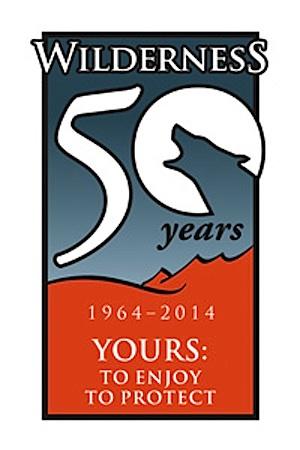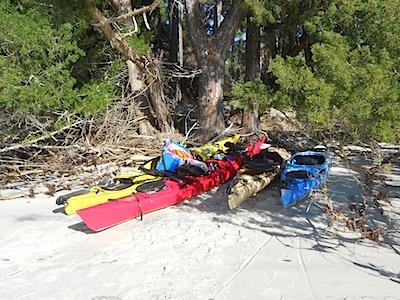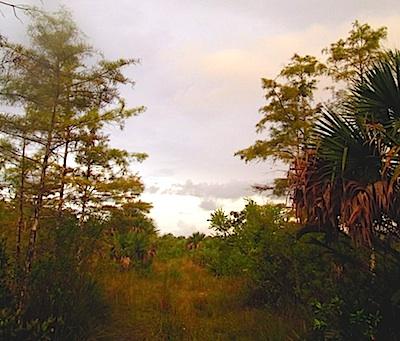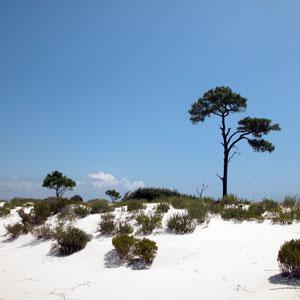Editor's note: The Wilderness Act turned 50 this year, and throughout the year it's been applauded far and wide, and even the National Park Service marked the anniversary with a series of videos celebrating wilderness settings. This weekend the Act is being honored with a conference in Albuquerque, New Mexico, that is being attended by Interior Secretary Sally Jewell and National Park Service Director Jon Jarvis. But how has the National Park Service handled wilderness issues? Jim Walters, who spent nearly 40 years working for the agency, including serving as Wilderness Program Coordinator for the Intermountain Region from 1988 until he retired in 2003, says the agency has not rallied around the Act.

Has the National Park Service worked faithfully with The Wilderness Act?
After 50 years, you would expect that the National Park Service, which administers the largest inventory of wilderness in the world, would have the best wilderness management program in the world. But, you would be very wrong. The fact of the matter is that the Park Service never wanted to be part of the Wilderness Act (P.L. 88-577) and the National Wilderness Preservation System in the first place, and testified a number times before congressional committees that it did not need to be included because 'national park lands were already protected as wilderness.'
The problem was that this statement simply wasn't true, and the environmental community and members of the Congress knew it wasn't true. People like David Brower of the Sierra Club had observed for years that national parks were always subject to development from political influences like the one proposing to dam the Green River at Echo Park in Dinosaur National Monument. Other developments were intended to improve the prospect that tourist dollars would flow into nearby communities. Developments proposed by the National Park Service itself were often misguided attempts to meet its dual mission of protecting and 'providing for the enjoyment' of park lands for future generations. And what better way to have the American public 'enjoy' the national parks than to build roads and visitor facilities in pristine areas where they were otherwise 'locked out.'
Because of the constant pressure to 'improve' national parks by developing them, the Congress pointedly and specifically identified the National Park Service as one of the four federal agencies responsible for implementing The Wilderness Act. The language of the Act is clear in telling the National Park Service that, regardless of how well it thought it might be protecting its public lands, it just wasn't doing enough and ordered it to meet the even higher standards for preservation prescribed in The Wilderness Act. The NPS didn't like this, and still doesn't.
Section 3 (c) of the Act states: 'Within ten years after the effective date of this Act the Secretary of the Interior shall review every roadless area of five thousand contiguous acres or more in the national parks, monuments and other units of the national park system...and shall report to the President his recommendations as to the suitability or non-suitability of each such area or island for preservation as wilderness.'
Section 4 (c) states: 'The purpose of this Act are hereby declared to be within and supplemental to the purposes for which national forests and units of the national park...are administered.'
Section 4 (3) (b) instructs: 'Except as otherwise provided in this Act, each agency administering any area designated as wilderness shall be responsible for preserving the wilderness character for the area and shall so administer such areas for such other purposes for which it may have been established as also to preserve its wilderness character.'
Sections 4 (c) states: 'Except as specifically provided for in this Act...there shall be no commercial enterprise and no permanent road within any wilderness area designated by this Act, and, except as necessary to meet minimum requirements for the administration of the area for the purpose of this Act'¦there shall be no temporary road, no use of motor vehicles, motorized equipment or motorboats, no landing of aircraft, no other form of mechanical transport, and no structure or installation within any such area.'
But, in spite of the direct instructions of The Wilderness Act, the environmental eloquence for wilderness delivered by people like Ralph Waldo Emerson and Henry David Thoreau, the wisdom of land stewards like Aldo Leopold and Bob Marshall, and the tireless energy of people like Howard Zahniser and David Brower, who worked for decades to finally get The Wilderness Act passed, the National Park Service decided to basically ignore this landmark piece of environmental legislation. After 50 years, the NPS wilderness program today consists of whatever minimum attention it could pay to wilderness and the continuation of its historic belief that it was 'already protecting wilderness.' And, unless the public does something about it, the NPS will continue to ignore wilderness for another 50 years.
One result of NPS wilderness neglect is that the public has been cheated out of having the world-class management program in place which should have established national park wilderness areas as the very best of the very best protected lands on Earth. Instead, we are left with an anemic façade of a program which, for the past 50 years, has done as little as possible to actually preserve NPS wilderness beyond lip service, forming committees, producing policy statements and directives which are not enforced, and the production of the odd video or two. The NPS also likes to attend the occasional public events like the 50th Anniversary celebration in Albuquerque to proclaim how much the agency regards wilderness and tell everyone what a great job it is doing to preserve it.

Could better oversight by the Park Service have led to a larger, single piece of wilderness, instead of four smaller parcels, at Cumberland Island National Seashore?/NPS
But we've heard all this before. Some of you might remember that in 1994 the NPS participated in a celebration in Santa Fe marking the 30th Anniversary of the Wilderness Act. All of the wilderness 'who's who' were in attendance'¦both of the Secretaries of the Interior and Agriculture, the directors of the four federal agencies charged by the Wilderness Act with the preservation of America's wilderness (the NPS, the U.S Forest Service, the Bureau of Land Management, and the U.S. Fish & Wildlife Service), representatives from prominent environmental groups, poets, entertainers, and dignitaries like former-Secretary of the Interior Stewart Udall and his son, then-Congressman Tom Udall. Everyone spoke glowingly (some even evangelically) about wilderness and its value to America.
In 1988, I had been transferred to the NPS regional office in Santa Fe and assigned responsibility for six different programs, including that of the Inter-Mountain Region's Wilderness Program Coordinator. But it didn't take long to realize that the reason I had been given the duties of the wilderness program coordinator was simple...nobody else was doing it, nobody wanted to do it, and nobody cared if anyone did it anyway. The historic attitude of the NPS was that wilderness just wasn't an important management issue to dedicate any time, funding, or manpower. In fact, it quickly became clear that the No. 1 threat to national park wilderness was'¦the National Park Service. Still, by 1994 I was glad to be part of an interagency steering committee putting together the 30th Anniversary celebration and hearing what I was hearing about the glories of wilderness from Washington office managers. Everyone had a swell time and we all went home happy. And then...nothing!
By the time I retired from a 40-year career with the National Park Service in 2004, it was more than obvious that the NPS had never been serious about applying either the letter, or spirit, of The Wilderness Act. And they weren't about to change just because they had someone like me reminding them that we were actually supposed to be preserving wilderness in keeping with this law, not just talking about it at conferences.
Ironically, wilderness, in one administrative category or the other, within 75 park areas, comprises almost 85 percent of the total land area administered by the NPS. The Wilderness Act, in addition to providing directions the agencies are supposed to follow if it has lands qualifying for the National Wilderness Preservation System, also prescribes management activities that are specifically prohibited within wilderness. All of which has been ignored by the NPS primarily because this agency does not like anyone, including the U.S. Congress, telling them what they can and cannot do with national park lands.

Should the National Park Service pushed for more, not less, wilderness in the Addition Lands of Big Cypress National Preserve/South Florida Wildlands Association
At the time I left the NPS, job announcements and the selection criteria to fill key management positions like superintendents, chief rangers, chief interpreters, etc., in wilderness parks most often never even mentioned the word 'wilderness.' The result was that people who knew nothing about wilderness, and some who were openly hostile to it, were selected to fill key positions in wilderness parks. It didn't really matter anyway, because the annual performance evaluations for these positions rarely mentioned wilderness in anything except the most ethereal terms. In short, you don't have to understand The Wilderness Act, or even like wilderness, to be a manager of an NPS wilderness park and still climb up the promotion ladder. Nobody gets in trouble in the National Park Service for ignoring wilderness; unless they get caught by the public.
Instead of having a robust program where wilderness preservation is integrated into all day-to-day and long-term management programs, today's NPS wilderness program consists of a thin façade of public relations gestures with an almost total lack of accountability, consistency, and continuity for the preservation of the resource itself. Chief among these shortcomings is the failure of most wilderness parks to have a comprehensive Wilderness Management Plan which spells out how wilderness is supposed to be preserved. A wilderness plan serves as a contract between the public and the NPS as how wilderness is to be preserved as well as identify who is responsible for this program. These plans provide the continuity for wilderness preservation through the turmoil of NPS staff changes and political trends. Without one, the preservation of wilderness is driven only by the whims of individual managers...both of which change often.
The public, especially the environmental community, is doing itself and wilderness a great disservice by not addressing this historic animosity towards The Wilderness Act and demanding from the NPS the answer to a basic question: After 50 years, what evidence can the NPS provide to show that national park wilderness resources have been protected in keeping with the requirements of The Wilderness Act and that wilderness is being protected differently from the other backcountry resources?
You will find that there is very little evidence to convict the NPS of the crime of actually protecting wilderness. Most of what they have is interpretive fluff intended to fool the public into believing that the agency is serious about wilderness while it continues to do things that fly directly in the face of the Wilderness Act. Sadly, evidence of the failings of the National Park Service in preserving wilderness is plentiful. During the 50-year-period since The Wilderness Act was passed the NPS has:
* Failed to complete the basic inventories and studies of lands suitable for wilderness
* Failed to fulfill the requirements of wilderness legislation by submitting the legal descriptions of its wilderness resources to the Congress
* Failed to abide by its own policies by not having approved wilderness management plans in parks which provide for the accountability, consistency and continuity of its wilderness program
* Failed to monitor whether or not wilderness is actually being protected on national park lands
* Failed to apply minimum requirement assessments for management activities conducted within wilderness
* Failed to provide more than a token administrative organization responsible for wilderness preservation at the park, regional, and Washington level offices
* Failed to account for the tens of thousands of dollars and man-hours spent sending NPS staff to wilderness training (which, ironically, is excellent) when it requires no quantifiable data showing that this training has benefitted park wilderness.
So, for the past 50 years, most of the National Park Service wilderness areas have none of the protections afforded by The Wilderness Act because the NPS does not make any significant effort to distinguish wilderness from its other backcountry areas. Wilderness continues to be treated as just another area of the park. The historic attitude towards The Wilderness Act has manifest itself in countless abuses of the Act itself:
In most wilderness parks, the use of motorized equipment and aircraft (especially helicopters), to conduct management activities has become basically routine. The decision to helicopter NPS archaeologist into and out of Bandelier National Monument because the superintendent decided that the 'the archaeologist's time was too valuable to be spent walking in and out of wilderness' (which is only about 23,000 acres) is not unusual. When the staff at Olympic National Park decided that the historic trail shelters in the park wilderness needed to be replaced (a questionable decision) and the only way they could do this was by building artificial shelters in the park maintenance yard and helicoptering these structures into the wilderness, the project continued even though the park was advised that this action violated both The Wilderness Act and NPS management policies. This project was only stopped when local environmental groups sued the Park Service. The judge hearing this case quickly ruled against the NPS.
Horn Island in the Gulf Islands Wilderness is abundant with brilliant white sand dunes covered with fragrant rosemary shrubs/NPS, Gail Bishop.The wilderness of Gulf Islands National Seashore arguably exists as the worst administered wilderness in the National Park System through the misuse of personal water craft and motorboats. The superintendent at Devils Postpile National Monument didn't even realize she had designated wilderness within the monument. The designated wilderness at Cumberland Island National Seashore was legislatively divided into four small separate units because the NPS had failed to control the authorized and unauthorized motor vehicle use on the island. The Colorado River Corridor within Grand Canyon National Park, a potential wilderness area, has been essentially hijacked by the concession tour operators using motorized watercraft. Researchers and park managers routinely use helicopters to access the recommended wilderness areas of Yellowstone National Park.
However, most of the wilderness abuses within the NPS are not reported at all due to fear of retribution by park managers. So, NPS wilderness continues to die a slow death from neglect and the thousand cuts resulting from management actions which are specifically prohibited by the Act, or those that do not meet a reasonable test for being the 'minimum requirement.' This comes not from the threat of giant oil and gas companies or the timber and mining industry attempting to raid national park lands, but from the continued indifference of the NPS towards The Wilderness Act. The dilution of wilderness values within parks has become the norm and the negligence of wilderness by the NPS has provided fodder for those opposing further additions to the National Wilderness Preservation System. After all, why do we need more wildernesses if we aren't even taking care of what we have?
Today, as we lament the fact that over the past four decades 50 percent of the Earth's wildlife has disappeared, The Wilderness Act stands as one of our last and best hopes for protecting our remaining ecosystems. The Wilderness Act exists as one of the world's great pieces of environmental legislation and deserves to be celebrated. It also deserves much better than the institutional neglect it has been afforded by the National Park Service.




Comments
Thanks for this op-ed, Kurt. Wilderness management, or rather the lack thereof, is one of the best examples of the common divergence between NPS image and NPS reality.
"This confusing duplicity is nothing new. The National Park Service (NPS) did not support the inclusion of national parks in the Wilderness System when the Act was signed in 1964 and the agency has never demonstrated a commitment to the Act. NPS Historian Richard Sellers has written: 'Although many of the National Park Service’s rank and file enthusiastically supported the wilderness bill, the bureau’s leadership seems to have drifted from outright opposition to reluctant neutrality.' The NPS has made this shift by conveniently writing inordinate flexibility into its management standards."
http://wildernesswatch.wordpress.com/2011/06/29/at-glacier-national-park...
Indeed, an excellent piece. All of my research supports this essay, especially the research I did for Yosemite: The Embattled Wilderness. Now, what is the cultural problem within the NPS that has led to this result? But of course, it is the worship of Stephen T. Mather and Horace M. Albright, who believed that the parks needed more tourism to survive, i.e., the Park Service itself need more bodies to convince Congress it was doing its job.
History is a powerful thing. If an organization starts well, it generally matures well. The Park Service started magnificently in some respects, but not all, and therein lies the problem with changing it today. Wilderness preservation came late to the environmental movement itself, which also believed in attracting more tourism in the early years following Hetch Hetchy. Early environmentalists also worked with the railroads to get more visitation; they also applauded the automobile for more visitation, too. Then people like David Brower realized that wilderness was the victim, especially when the Bureau of Reclamation proposed dams in Dinosaur National Monument and Grand Canyon.
The bottom line here is this: It is not just the Park Service that has failed wilderness, nor is it just the Park Service failing wilderness today. Wilderness is everywhere on the chopping block over renewal energy, and most environmental groups are playing right along. It's downright appalling what they accept for the Mojave Desert, but hey, we need to save the earth from climate change!
As for all wilderness, we have academic license that Native Americans were in it first--and themselves believed in changing it. It is not Aldo Leopold at the University of Wisconsin today. Wilderness is the "wrong nature"; it is artificial. If academics are saying that, why not the Park Service?
Seventy-five years ago, the Park Service could still find enthusiastic supporters--and mentors for new hires--in places like UC Berkeley, the University of Washington, Harvard, Rutgers, and Yale. Most of that support is gone, now riddled with guilt over defending anything American lest their own careers come to a halt.
A great essay, but the problem runs deep, and indeed, far deeper than most of us know.
I have a friend who teaches a course that chronicles the fracturing of the conservation movement in the way Alfred Runte describes. (We had a long talk about it as we were backpacking through the old-growth Quinault rainforest in Olympic NP.) It does seem that wilderness has been marginalized. I still think, though, that there is an argument that can define American exceptionalism in terms of wilderness, which can be palatable to that aging segment of the academic left Alfred seems to be describing.
I don't see how it would help or would have helped the NPS or the public to virtually lock out the vast majority of people that currently visit the great parks like Yosemite, Yellowstone, Rocky Mountain, Smokies, et al.
For some of you that is OK because "Wilderness" is more important than humans. I'm not in that camp.
"The idea of wilderness needs no defense, it only needs defenders.”
― Edward Abbey
How would creating wilderness "lock out the vast majority of people" that visit parks? Backcountry travel is a very small segment of traffic in the national parks, and designating areas currently being managed as wilderness shouldn't lock out anyone who is interested in trekking into those regions under the current management. And it certainly won't affect front-country travelers, who constitute the vast majority of park visitors.
Areas in parks already threaded with roads and dotted with lodges and stores won't be impacted.
Wilderness designations will, however, prevent the growth of development in the parks. Are you suggesting we need more roads and lodges in the parks?
That is my point. If Yosemite, Yellowstone etc had been managed as Wilderness from day one, the only way to visit them would have been by backcountry travel.
It depends. But we don't need "Wilderness" designation or management to prevent it.
Then again, given the constant pressures to permit more and more "recreational" use of park lands, maybe wilderness designation is more important now than it ever has been.
This was an excellent piece. Kudos to Jim Walters for writing it.